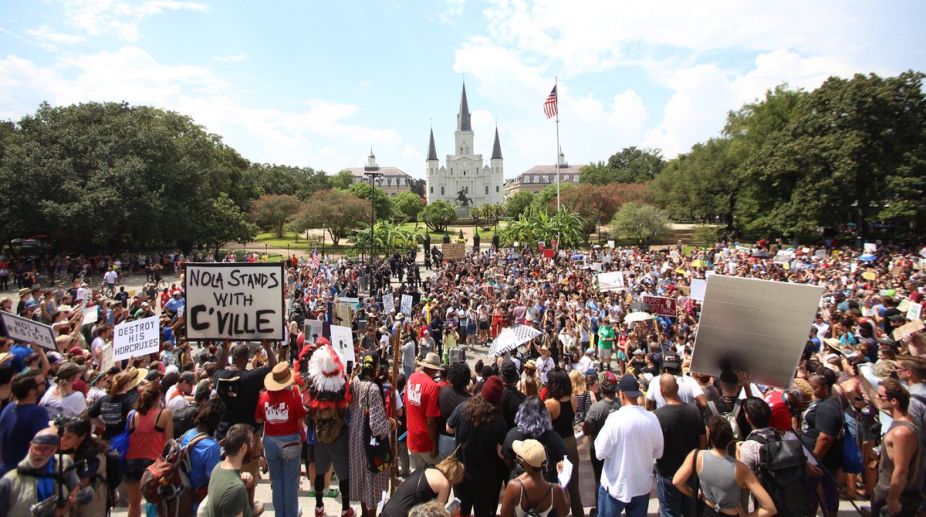What has happened in Charlottesville showed that temperatures and tempers are flaring in this long hot summer.
Is the Arab Spring spreading worldwide due to climate warming? The Arab Spring broke out in 2011 with a wave of demonstrations and protests in Oman, Yemen, Egypt, Syria and Morocco. This was hailed as the outbreak of democracy against authoritarian regimes, but what went unnoticed were the underlying causes of three interconnected factors – a growing youth unemployment bulge from rapid population growth, the inability of existing governance structures to deal with growing social stresses and the catalyst for social breakdown – climate change.
From February to August 2010, a large-scale, drought and famine occurred in Africa’s Sahel region, the belt below the Sahara desert stretching from Senegal, Northern Nigeria, Mali to Sudan. The drought killed an estimated 260,000 people and caused migration northwards to North Africa. Indeed, before the fall of Libyan leader Gaddafi in late 2011, the EU paid Libya 50 million euros in October 2010 to stop African migrants passing into Europe. From 2006 to 2011, Syria suffered one of the worst droughts and famine that covered 60 per cent of its land area, causing massive crop failure and loss of herds.
In February this year, the United Nations declared another famine in South Sudan, with famine risks in Nigeria, Somalia and Yemen.
The famine in Yemen is already threatening 7 million people. The UN blamed the cholera outbreak there as man-made by the current civil war. 2016 was the hottest year in recorded history, since records began to be kept in 1880. Sixteen of the 17 hottest years have occurred since 2000. Indeed, by mid-year, 2017 may be the second hottest year ever, with increasing scientific evidence that the continual temperature rise will lead to more cyclones, rise in sea levels, faster decline in the polar ice caps and more unpredictable weather changes.
The January 2017 US National Intelligence Council’s Global Trends report argued that global tensions will rise in the coming five years from five key stresses: economic, political, social, geopolitical and environmental. The economic stress comes from slowing global growth, creating less resources to deal with the huge welfare and social gaps that shape politics. Political stress is rising because failing governments don’t have the capacity to address the challenges that they face. This is particularly evident in the Middle East and North Africa, the most water-stressed region in the world.
The report argues that “societal confrontation and polarisation – often rooted in religion, traditional culture, or opposition to homogenising globalisation – will become more prominent in a world of ever-improving communications.”
The improved communications have not only enabled militant extremists and terrorist groups to have transnational presence, but also faster spread of infectious diseases. Geopolitical stress has arisen because of growing inter-state rivalry for power and resources.
Finally, environmental stress is moving centre stage as global warming generates greater freakish storms, melting ice, rising sea levels, worsening the abilities of fragile governments, already weakened by corruption, social dissent and insufficient resources to cope.
These five stresses are mutually reinforcing, because deterioration in one makes the other stresses worse. For example, if the sea level rises, not only would food producing zones, such as the Mekong delta, be subject to flooding, but the increased salt content would reduce rice production.
It has already been claimed that greater ocean weight stresses on continental shelves may lead to more earthquakes and volcanic disruptions. The costs of dealing with natural disasters are becoming serious. The economic damage caused by Hurricane Katrina on the US in 2005 was estimated at $250 billion, of which only $35 billion was covered by insurance.
According to the Economist magazine, in the 12 months to April 2014, the Indian central and state governments spent $92 billion dealing with floods, droughts and other disasters. The Paris Climate Change Agreement has promised a measly $100 billion a year to help developing countries reduce their carbon footprint.
Trump’s decision to pull the US out of the Paris climate agreement will not only reduce these resources further, but his policies on growth at the expense of environment may also add to more carbon emission from the US, already a major contributor to carbon warming. The Charlottesville protests over the dismantling of a Civil War statue resulting in violence between white supremacists and other protestors suggest that long hot summers are associated with violence.
According to a study by Berkeley and Princeton published in Science magazine (www.sciencemag.org), a global temperature rise of 2 degrees celsius could increase the rate of intergroup conflicts, such as civil wars, by over 50 per cent in many parts of the world. Another study by psychologists Plante and Anderson 2017 (www.psychologicalscience.org) suggested a high correlation between heat stress and aggression and violence. Children growing up in climate stressed countries may become more antisocial due to undernourishment from food and water shortages.
The other impact is ecomigrationdriven conflict. The illegal migration of over 15 million Bangladeshis into India, according to a Carnegie India 2016 study, created social tension along border areas. Europe faces today more than 1 million annual migrants if the waterstressed regions of Middle East and North Africa suffer further deterioration in food, water and security.
The dilemma for Europe is not just about how to police its borders, but how to deal with the climate change stresses in her neighbours so that the ecomigration pressure will be lessened. No one has quantified how much such investments will cost. Simply put, climate change is no longer a long-term issue, but a clear and present danger. Each of us has to take responsibility for climate change, because it is the collective human excessive consumption that is changing our eco-system.
A hotter and more violent earth is not fake news. That is why Earth First comes before America First or individuals first. Hotter climates will need cooler heads than Trump to think through what we should be doing to deal with climate change.
(The writer, a former Central banker, writes on global issues from an Asian perspective. Special to ANN.)











